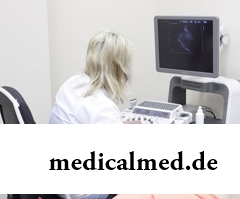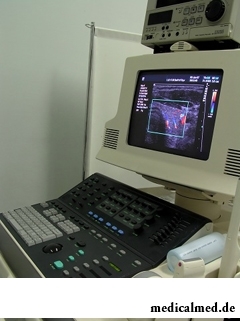





Echocardiography
 Echocardiography – one of methods of ultrasonic diagnosis applied to researches of functional and morphological changes of heart and its structures. This diagnostic method allows to estimate a condition of heart valves in the visualization mode. Ekhokardiogramma is widely applied to early diagnosis of cardiological diseases that gives the chance in time to reveal pathology.
Echocardiography – one of methods of ultrasonic diagnosis applied to researches of functional and morphological changes of heart and its structures. This diagnostic method allows to estimate a condition of heart valves in the visualization mode. Ekhokardiogramma is widely applied to early diagnosis of cardiological diseases that gives the chance in time to reveal pathology.
Indications to carrying out an echocardiography of heart
Performing ultrasound examination of heart is appointed at:
- Noise of various degree and localization in heart;
- Feverish conditions of the uncertain reason;
- Detection of changes on an ECG;
- Suspicions on existence of the inborn or acquired heart diseases;
- Visible disturbances on the roentgenogram – at increase in the sizes of heart or its structures, a modified aorta, accumulation of kaltsinat;
- Arrhythmias, including felt;
- Hereditary serious pathologies of cardiovascular system;
- Complaints to faints, stethalgias, hypostases of legs, severe short wind and frequent dizzinesses;
- Increase in arterial pressure;
- The postponed myocardial infarction;
- Suspicion on existence of a tumor of heart, and also on expansion of chest department of an aorta.
 The echocardiography of heart allows to reveal existence of new growths and to diagnose various defeats. In addition the ekhokardiogramma is used for monitoring of a state at an ischemic disease, inborn heart diseases, after the postponed heart attack, at a cardiomyopathy and arterial hypertension.
The echocardiography of heart allows to reveal existence of new growths and to diagnose various defeats. In addition the ekhokardiogramma is used for monitoring of a state at an ischemic disease, inborn heart diseases, after the postponed heart attack, at a cardiomyopathy and arterial hypertension.
Also the echocardiography of heart is recommended to pass at the regular sports trainings and other occupations causing the strengthened load of heart or at constant emotional pressure. At children's age, in the course of snowballing and growth at the child, and especially at suspicions of inborn heart disease, the ekhokardiogramma is also appointed.
Fruit echocardiography
The inborn heart diseases which are one of the main reasons for perinatal mortality can be diagnosed by a fruit echocardiography method. This procedure is harmless to a fruit and allows to estimate an endocardiac hemodynamics in the pre-natal period, and also to exercise dynamic control of indicators throughout pregnancy at identification of systolic noise in heart. This method of an ekhokardiogramma of heart and vessels is often applied to assessment of a condition of bodies till the child's birth that allows to make timely the diagnosis and to begin treatment practically right after the birth. The fruit echocardiography in details inspects heart and blood vessels, revealing inborn disturbances in its work.
If necessary the echocardiography of a fruit is carried out on 18 – 22 week of pregnancy. Indications to purpose of diagnosis are:
- Inborn heart diseases at relatives;
- Abortions before the current pregnancy;
- Diabetes mellitus;
- Reception of antibiotics, and also medicines from epilepsy in the first trimester;
- The deviations recorded on planned ultrasonography of a fruit on the 20th week.
Interpretation of an echocardiography of a fruit is carried out by cardiologists or the doctor geneticist.
Methods of carrying out echocardiography of heart
Depending on indications the echocardiography of heart can be carried out by several methods allowing to estimate various parameters:
- Echocardiography in the M-mode – the sizes of heart and systolic work of ventricles;
- Two-dimensional echocardiography – thickness of walls and the sizes of cardial cavities, contractility of ventricles, a condition of valves, and also existence or absence of thrombosis of cavities;
- Transesophageal – a back wall of heart, usually after the postponed heart attack of the lower wall of heart;
- Intravascular ultrasound – a condition of coronary vessels;
- Volume modeling of heart;
- Doppler research – the central dynamics;
- Stress – the changes of various segments of heart caused by exercise stresses;
- Contrast echocardiography – a condition of cameras of heart.
Interpretation of an echocardiography is carried out by the cardiologist. On the basis of the carried-out diagnosis the researcher more than hundred initial and settlement indicators are possible and to estimate objectively:
- Contractility;
- State and function of valves;
- Functional condition of a myocardium;
- Existence of endocardiac blood clots;
- Indicators of pumping function and contractility of a left ventricle in dynamics;
- Sizes of cardial cavities;
- Thickness of walls of heart;
- Existence of hems;
- Degree of a hypertrophy of heart cameras.
Contraindications to carrying out an echocardiography
Echocardiography – the safe diagnostic procedure which does not have absolute contraindications. However at deformation of a thorax which interferes with normal diagnosis and also some allergic and inflammatory damages of skin in heart, its carrying out can be difficult.
The most rare disease – a disease the Kura. Only representatives of the tribe Faure in New Guinea are ill it. The patient dies of laughter. It is considered that eating of a human brain is an origin of a disease.

Insufficiently strongly expressed sexual desire or lack of satisfaction from sexual contacts can test time from in...
Section: Articles about health
Each person knows that fervescence is an illness sign. However too low temperature (hypothermia), especially also can demonstrate existence of diseases when it is observed long enough. Such state is dangerous those...
Section: Articles about health
Statistically, at the address to doctors seven of each ten patients complain of a headache. Actually it is much more people who are periodically feeling unpleasant feelings such. Many people, apart from a headache the reason for serious fears, prefer to muffle independently the next attack medicines. Such behavior is extremely careless, especially if this symptom appears regularly and is followed by other signs of an indisposition. Constants head Bol...
Section: Articles about health
Urogenital candidiasis (milkwoman) – a fungal infection which annoys unpleasant feelings in the field of generative organs, сопр...
Section: Articles about health
Weakness of an ankle joint – very widespread problem. Its existence is demonstrated by tendency to a podvorachivaniye of legs when walking on heels, frequent painful sprains, pain on average and anonymous toes even after small nagruzo...
Section: Articles about health
For anybody not a secret that our country is one of the most "drinking" in the world. At clear understanding that the use of hard alcoholic drinks – occupation extremely harmful, most of Russians belong to alcoholism with unjustified loyalty. Apparently, existence of a set of myths in which tendency to excessive libations looks nearly positively is explained by it. It is worth getting acquainted with the most widespread of similar delusions and to be convinced in them not...
Section: Articles about health
Beauty shop – the place which is associated only with positive emotions: joy, pleasure, relaxation. One...
Section: Articles about health
Bulimia and anorexia, are heavy deviations of a feeding behavior, become a cause of death of patients much more often than all other nervous breakdowns combined. In 60% of cases two illnesses accompany each other: patients feel horror before danger on...
Section: Articles about health
All like to sing. Small children with pleasure are engaged in a vocal, not especially thinking of hit in a melody. Adults most often hesitate, being afraid to show lack of talents in this area, and it is vain: singing is very useful for health....
Section: Articles about health
The healthy nutrition is the invariable principle of health and good health for long years of the woman. Nevertheless, in рацио...
Section: Articles about health
It seems, quite recently you brought the baby from maternity hospital, but time flew by, and here it is already going to join the first in life children's collective. How to prepare the child for visit of a garden? What needs to teach him to facilitate process адап...
Section: Articles about health
Practice of hypnotic impact on consciousness of the person contains about two millennia. During this time scientists managed to learn a lot of things about a phenomenon of hypnosis and learned to facilitate a condition of the patients having heavy illnesses with its help....
Section: Articles about health
History of mankind contains several tens of epidemics whose emergence was compared by eyewitnesses and historians to doomsday. With...
Section: Articles about health
The advantage of swimming for the person is so high that this sport is not only the most popular, but also is widely applied in medicine and rehabilitation processes. If you look for for yourself the occupation allowing pleasantly and to spend time, then swimming with advantage...
Section: Slideshow
Mushrooms - the surprising inhabitants of our planet having a set of wonderful qualities. Thanks to one of them, a mold mushroom of Penicillium notatum, the first natural antibiotic - penicillin was received nearly 80 years ago. The mankind is obliged to this opening by millions of saved lives....
Section: Articles about health
Run - one of the most available and effective ways to revitalize the organism. Knowing about its extraordinary advantage, each of us though...
Section: Articles about health
Cold – a state known to everyone which is followed by cold, cough, high temperature, a pharyngalgia. Often the first that we begin to do in hope again to become healthy – to accept medicines which are not always harmless, then...
Section: Articles about health
Shops of household appliances offer us the huge choice of various devices for the house. Whether there are among this abundance devices which not only facilitate house work, but also help to keep health of the person? Of course, and we will tell about them today....
Section: Articles about health
We present to yours the TOP of the medicamentous means exerting the stimulating impact on a potentiality, i.e. on ability of a muzhcha...
Section: Articles about health
Long time antibiotics were considered as a panacea from all diseases and were appointed even at insignificant symptoms of an infection. Even now not everyone knows in what force of antibiotics how and when they should be accepted. Let's discredit 7 popular myths about such drugs...
Section: Articles about health
Is told about advantage of domestic animals for development of the child much. But many parents nevertheless do not hurry to bring pets as are afraid that they can do harm to health of children. What troubles can really trap kids and how to make joint life of a family and domestic animals comfortable and safe?...
Section: Articles about health
Quite large number of people adheres to the principles of vegetarian food. But how to be if in a family of vegetarians is д...
Section: Articles about health
The kid who was recently born is surrounded with love of adult family members and their cares without which the baby cannot exist. Some parents consider that gentle attachment and caress are quite enough that the child correctly developed and was happy...
Section: Articles about health
Herpes simplex of the first type (the infectious disease which is shown periodic bubble rashes on lips is called) – one of the most widespread illnesses. Statistically, only 5% of inhabitants of our planet are unreceptive to its activator, and the reasons of this feature are still not found out. Other people are virus carriers....
Section: Articles about health
The state of health of the person in many respects depends on chemical composition of biological liquids of an organism. Specialists consider that з...
Section: Articles about health
The thought that the mass of their body is too big at least once in life visits from 80 to 95% of women. Many women are so obsessed with this idea that constantly try all new and new ways of weight reduction. Considerable part of these method...
Section: Articles about health
It is pleasant to state a possibility of improvement of quality of life of people with problems of functioning of secretory system. Efforts of talented inventors created products which will be able to provide normal life activity of clients with moderate degree of a disease, it is essential to facilitate the help to patients with strongly expressed disturbances....
Section: Articles about health
